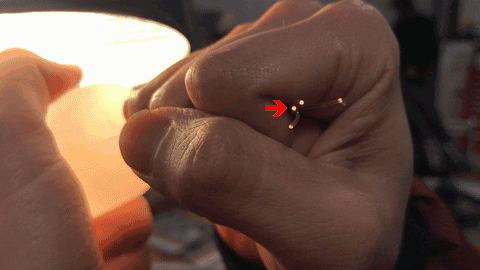Sensitive Surface (2017)
This is my on-going expeirment that explores ways to give life to objects made of soft materials so people can seamlessly interact with soft objects.
Concept
Sensitive Surface is a surface that can feel touches and react to the stimulation just like human skin does. This is enabled by embedding flexible materials such as optic fiber or conductive liquid to extend the sensing ability of commonly used sensors.
![]()
Prototypes
Prototypes are made of liquid silicone poured in molds and vacuum casted. One prototype used optic fiber and the other used conductive ink as a medium to extend the ability of existing sensors. I chose the two materials because they are flexible and bendable enough to keep the softness of the object.
Type 1. Optic Fiber with Light Sensor
The first prototype uses optic fiber to extend the sensing range of light sensors. I embedded optic fiber strands in four different parts of a silicone object. One end of each strand acts as a sensing point.
![]()
When areas around the one end of an optic fiber is touched by a finger, the finger blocks lights which coming from one end of the optic fiber strand. The change is visibly observed from the other end of the optic fiber (see the gif below). By attaching light sensors on the other end of each strand, it is possible to detect which part of an object is being touched.
![]()
Type 2. Conductive Ink with Capacitive Sensor
For the other prototype, I used conductive ink to extend the capability of capacitive sensors. To cure thin strands of conductive ink in the middle of a silicone mass, 1) I casted a layer of silicone with channels, 2) injected conductive ink along the channel, and 3) casted the second layer of silicone on top of the first layer.
![]()
A capacitive sensor will be attached to one end of the conductive ink strand to sense human touches from the other end.
![]()
Potential Benefits
By extending the ability of sensors using flexible materials, it is possible to hide hard electronic parts behind soft objects which enables entire softness of objects. The technique is applicable to any surfaces with arbitrary shapes and curves.
Applications
The concept and technique can be used to add interactivity on any soft objects. The application area includes interactive toys, smart wearables, prosthesis, and tangible input/output devices for VR experience.
Concept
Sensitive Surface is a surface that can feel touches and react to the stimulation just like human skin does. This is enabled by embedding flexible materials such as optic fiber or conductive liquid to extend the sensing ability of commonly used sensors.

Prototypes
Prototypes are made of liquid silicone poured in molds and vacuum casted. One prototype used optic fiber and the other used conductive ink as a medium to extend the ability of existing sensors. I chose the two materials because they are flexible and bendable enough to keep the softness of the object.
Type 1. Optic Fiber with Light Sensor
The first prototype uses optic fiber to extend the sensing range of light sensors. I embedded optic fiber strands in four different parts of a silicone object. One end of each strand acts as a sensing point.

When areas around the one end of an optic fiber is touched by a finger, the finger blocks lights which coming from one end of the optic fiber strand. The change is visibly observed from the other end of the optic fiber (see the gif below). By attaching light sensors on the other end of each strand, it is possible to detect which part of an object is being touched.

Type 2. Conductive Ink with Capacitive Sensor
For the other prototype, I used conductive ink to extend the capability of capacitive sensors. To cure thin strands of conductive ink in the middle of a silicone mass, 1) I casted a layer of silicone with channels, 2) injected conductive ink along the channel, and 3) casted the second layer of silicone on top of the first layer.

A capacitive sensor will be attached to one end of the conductive ink strand to sense human touches from the other end.
Potential Benefits
By extending the ability of sensors using flexible materials, it is possible to hide hard electronic parts behind soft objects which enables entire softness of objects. The technique is applicable to any surfaces with arbitrary shapes and curves.
Applications
The concept and technique can be used to add interactivity on any soft objects. The application area includes interactive toys, smart wearables, prosthesis, and tangible input/output devices for VR experience.